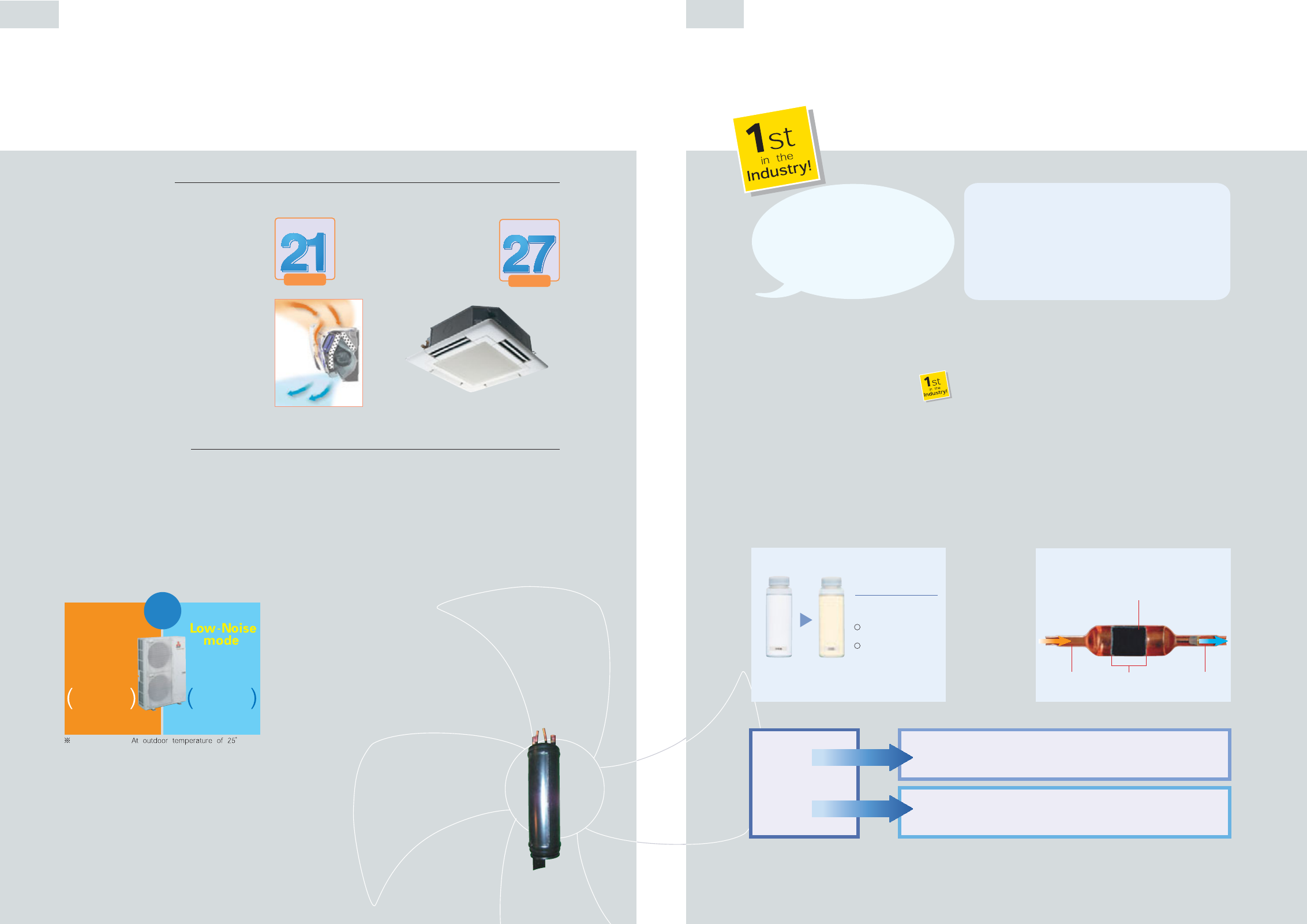
dB
Only
MSZ-FA/GA25
1/2
noise
Operation has been made very silent by
improvements to the design of the fan
blades and the new grille shape. The
outdoor unit is even more silent when
outside temperature drops as it
automatically switches to low-noise
mode to reduce operating noise by 3dB.
Silent Operation
A low-noise priority function is also available
by connecting a commercially available
timer or a selector switch. When a signal is
received from the timer or the switch, the
unit runs in low-noise priority mode.
Low-Noise Priority Function
C
Ultra Silent Indoor Unit Operation
Noise level during normal operation is
only 21dB for the new MSZ-FA/GA25,
making it one of the quietest indoor units
in the industry. Inside the unit, the multi-
angled heat exchanger has a modified fin
shape that reduces air resistance for a
smoother, quieter airflow. The wide fan
diameter produces greater airflow at
lower fan speeds and the uneven pitch
between each fan blade helps to
eliminate annoying noise. What’s more,
the remote controlled vane significantly
decreases downward air resistance for
much lower noise levels.
Quiet 4 way Cassette
Reduced airflow resistance
and a redesigned shape of
the heat exchanger fin
make very quiet operation.
Q.
A.
In general, why is the reuse of existing
pipework not allowed for models with
R407C or R410A HFC refrigerant?
This is because existing pipework contains moisture and
chloride residue that, when mixed with compressor's
ester oil, can result in a chemical reaction. Additionally,
refrigerant oil sludge and corrosion within the
compressor can clog up the refrigerant circuit.
Our Inverter-driven models are the first in
the industry to use hard alkyl benzene
(HAB) oil — a unique refrigerant oil that
degrades very slowly — for refrigeration.
Employing our exclusive cleaning-free
technologies such as a specially developed
high-efficiency oil separator and optimum
distribution of heat exchangers to prevent
oil stagnation, we have made it possible
to reuse previously installed pipeworks.
MSZ Series, MXZ Series (except for MXZ-8A140VA),
PUHZ-RP35/50/60/71 Features
New HAB Refrigerant Oil
The refrigerant oil (ester oil) used for the
10.0~25.0kw models will degrade when
mixed with chemicals such as chloride
found in existing pipes. To prevent oil
degradation and make it possible to reuse
existing pipes, Mitsubishi Electric has
developed an exclusive replacement filter
that uses activated charcoal to soak up
chlorides.
PUHZ-RP100/125/140/200/250 Features
Exclusive Replacement Filter
Mitsubishi Electric’s Cleaning-Free Technology
Replacement filter (conceptual diagram)
Refrigerant circuit lasts longer with less deterioration
using the new HAB refrigerant oil*
*Data taken from our lab: Test results equivalent to 10 years worth of use
Characteristics of the new
refrigerant oil
Colour of the oil
at initial stage
Colour of the oil at
10 years after use
Name: HAB Oil
Oil characteristics:
Difficult to dissolve in
the refrigerant.
High chemical and heat
stability, uniform quality,
high fluidity and viscosity.
Activated carbon
(absorbs chlorine and other chemicals)
Filter
Outlet
RefrigerantRefrigerant
Inlet
1
2
Silent Operation Technology
Cleaning-Free, Pipe Reuse Technology
DAY
50dB
in
cooling mode
NIGHT
47dB
*
in
cooling mode
( PUHZ and Power Multi )
Indoor Unit
Outdoor Unit
dB
Only
PLA-RP35AA
• Reduces installation time for less disruption of business.
• Saves installation costs.
• Installation time is reduced significantly, so you have more time to do other work.
• Not necessary to find proper pipings for R410A refrigerant.
• Time-consuming pipe cleaning is not necessary, even if the owner wants to
reuse the existing pipework.
Advantages
For tenants /owner
For installer
Refrigerant condensed in the condenser
of the outdoor unit is heat-exchanged
with the low temperature refrigerant
inside the accumulator, and subcooled.
Doing this way, refrigerant will reach the
LEV (Linear Expansion Valve) while
keeping the optimum state even when
the branch box is installed far from the
outdoor unit.
This has enabled to reduce the
refrigerant noise at the LEV
section, and has optimized the
refrigerant distribution to each
indoor unit, proving great
effectiveness in the installation
environment with a large piping
loss (pressure loss) due to a long
piping length or a large height
difference.
Reduction of
Refrigerant Noise
PUHZ
-
RP125/140
:
9
10


















